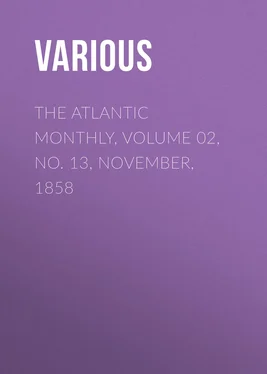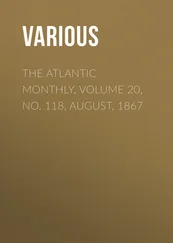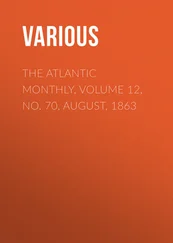Various - The Atlantic Monthly, Volume 02, No. 13, November, 1858
Здесь есть возможность читать онлайн «Various - The Atlantic Monthly, Volume 02, No. 13, November, 1858» — ознакомительный отрывок электронной книги совершенно бесплатно, а после прочтения отрывка купить полную версию. В некоторых случаях можно слушать аудио, скачать через торрент в формате fb2 и присутствует краткое содержание. Жанр: foreign_antique, periodic, foreign_edu, на английском языке. Описание произведения, (предисловие) а так же отзывы посетителей доступны на портале библиотеки ЛибКат.
- Название:The Atlantic Monthly, Volume 02, No. 13, November, 1858
- Автор:
- Жанр:
- Год:неизвестен
- ISBN:нет данных
- Рейтинг книги:4 / 5. Голосов: 1
-
Избранное:Добавить в избранное
- Отзывы:
-
Ваша оценка:
- 80
- 1
- 2
- 3
- 4
- 5
The Atlantic Monthly, Volume 02, No. 13, November, 1858: краткое содержание, описание и аннотация
Предлагаем к чтению аннотацию, описание, краткое содержание или предисловие (зависит от того, что написал сам автор книги «The Atlantic Monthly, Volume 02, No. 13, November, 1858»). Если вы не нашли необходимую информацию о книге — напишите в комментариях, мы постараемся отыскать её.
The Atlantic Monthly, Volume 02, No. 13, November, 1858 — читать онлайн ознакомительный отрывок
Ниже представлен текст книги, разбитый по страницам. Система сохранения места последней прочитанной страницы, позволяет с удобством читать онлайн бесплатно книгу «The Atlantic Monthly, Volume 02, No. 13, November, 1858», без необходимости каждый раз заново искать на чём Вы остановились. Поставьте закладку, и сможете в любой момент перейти на страницу, на которой закончили чтение.
Интервал:
Закладка:
Various
The Atlantic Monthly, Volume 02, No. 13, November, 1858 / A Magazine of Literature, Art, and Politics
RAILWAY-ENGINEERING IN THE UNITED STATES. 1 1 Handbook of Railroad Construction , for the Use of American Engineers. By GEORGE L. VOSE, Civil Engineer. Boston and Cambridge: James Munroe & Company. 1857. Baltimore and Ohio Railroad Reports , from 1830 to 1850. BENJAMIN H. LATROBE, Chief Engineer. Railways and their Management , being a Pamphlet written by JAMES M. WHITON, ESQ., late of the Boston, Concord, and Montreal Railroad. 1856. Report of the President, Treasurer, and General Superintendent of the New York and Erie Railroad Company to the Stockholders . March, 1856. Final Report of JOHN A. ROEBLING, Civil Engineer on the Niagara Railway Suspension-Bridge , May, 1855.
Though our country can boast of no Watt, Brindley, Smeaton, Rennie, Telford, Brunel, Stephenson, or Fairbairn, and lacks such experimenters as Tredgold, Barlow, Hodgkinson, and Clark, yet we have our Evans and Fulton, our Whistler, Latrobe, Roebling, Haupt, Ellet, Adams, and Morris,—engineers who yield to none in professional skill, and whose work will bear comparison with the best of that of Great Britain or the Continent; and if America does not show a Thames Tunnel, a Conway or Menai Tubular Bridge, or a monster steamer, yet she has a railroad-bridge of eight hundred feet clear span, hung two hundred and fifty feet above one of the wildest rivers in the world,—locomotive engines climbing the Alleghanies at an ascent of five hundred feet per mile,—and twenty-five thousand miles of railroad, employing upwards of five thousand locomotives and eighty thousand cars, costing over a thousand millions of dollars, and transporting annually one hundred and thirty millions of passengers and thirty million tons of freight,—and all this in a manner peculiarly adapted to our country, both financially and mechanically.
In England the amount of money bears a high proportion to the amount of territory; in America the reverse is the case; and the engineers of the two countries quickly recognized the fact: for we find our railroads costing from thirty thousand to forty thousand dollars per mile,—while in England, to surmount much easier natural obstacles, the cost varies from seventy-five to one hundred thousand dollars per mile.
The cost of railroad transport will probably never be so low as carriage by water,—that is, natural water-communication; because the river or ocean is given to man complete and ready for use, needing no repairs, and with no interest to pay upon construction capital. Indeed, it is just beginning to be seen all over the country that the public have both expected and received too much accommodation from the companies. Men are perfectly willing to pay five dollars for riding a hundred miles in a stage-coach; but give them a nicely warmed, ventilated, cushioned, and furnished car, and carry them four or five times faster, with double the comfort, and they expect to pay only half-price,—as a friend of the writer once remarked, "Why, of course we ought not to pay so much when we a'n't half so long going,"—as if, when they paid their fare, they not only bargained for transport from one place to another, but for the luxury of sitting in a crowded coach a certain number of hours. It would be hard to show a satisfactory basis for such an establishment of tolls. We need not wonder at the unprofitableness of many of our roads when we consider that the relative cost of transport is,—
By Stage, one cent,
By Railroad, two and seven-twelfths;
and the relative charge,—
By Stage, five cents,
By Railroad, three cents;
and the comparative profit, as five less one to three less two and seven-twelfths, or as four to five-twelfths , or as nine and six-tenths to one .
America has, it is true, a grander system of natural water-communication than any other land except Brazil; but, for all that, there is really but a small part of the area, either of the Alleghany coal and iron fields, or of the granaries of the Mississippi valley, reached even by our matchless rivers. A certain strip or band of country, bordering the water-courses, is served by them both as regards export and import; just as much is served wherever we build a railroad. In fact, whenever we lay a road across a State, whether it connects the West directly with the East, or only with some central commercial point in the West, just so often do we open to market a band of country as long as the road, and thirty, forty, or fifty miles wide,—the width depending very much upon the cost of transport over such road; and as the charge is much less upon a railroad than upon a common road, the distance from the road from which produce may be brought is much greater with the former than with the latter. The actual determination of the width of the band is a simple problem, when the commercial nature of the country is known.
The people of the great valley have not been slow, where Nature has denied them the natural, to make for themselves artificial rivers of iron. These railroads are more completely adapted to the physical character of the Western States than would be any other mode of communication. The work of construction is oftentimes very light, little more being necessary for a railway across the prairies of the West (generally) than a couple of ditches twenty or thirty feet apart, the material taken therefrom being thrown into the intermediate space, thus forming the surface which supports the crossties, the sills or sleepers, and the rails. Indeed, the double operation of ditching and embanking is in some cases performed by a single machine, (a nondescript affair, in appearance half-way between a threshing-machine and a hundred-and-twenty-pound field-piece,) drawn by six, eight, or ten pairs of oxen.
It is even probable that in a great many cases the common road would cost more than the railway in the great central basin of America; as the rich alluvial soil, when wet in spring or fall, is almost impassable, and lack of stone and timber prevents the construction of artificial roads.
The influence of the railroad upon the Western farm-lands is quickly seen by the following figures, extracted from a lately published work on railroad construction.
Table showing the Effect of Railroad Transport upon the Value of Grain in the Market of Chicago, Illinois .
At market $49.50 49.50 25.60 25.60
Carried 10 m. 49.25 48.00 24.25 23.26
do. 50 m. 48.75 42.00 24.00 17.25
do. 100 m. 48.00 34.50 23.25 9.75
do. 150 m. 47.25 27.00 22.50 2.25
do. 200 m. 46.50 19.50 21.75 0.00
do. 300 m. 45.00 4.50 20.25 0.00
do. 330 m. 44.55 0.00 19.80 0.00
Thus a ton of corn carried two hundred miles costs by wagon transport more than it brings at market,—while, moved by railroad, it is worth $21.75. Also wheat will not bear wagon transport of 330 miles,—while, moved that distance by railroad it is worth $44.55 per ton.
The social effect of railroads is seen and felt by those who live in the neighborhood of large cities. The unhealthy density of population is prevented, by enabling men to live five, ten, or fifteen miles away from the city and yet do business therein. The extent of this diffusion is as the square of the speed of transport. To illustrate. If a person walks four miles an hour, and is allowed one hour for passing from his home to his place of business, he can live four miles from his work; the area, therefore, which may be lived in is the circle of which the radius is four miles, the diameter eight miles, and the area 501/4 square miles. If by horse he can go eight miles an hour, the diameter of the circle becomes sixteen miles, and the area 201 square miles. Finally, if by railroad he goes thirty miles an hour, the diameter becomes sixty miles, and the area 2,827 square miles.
Читать дальшеИнтервал:
Закладка:
Похожие книги на «The Atlantic Monthly, Volume 02, No. 13, November, 1858»
Представляем Вашему вниманию похожие книги на «The Atlantic Monthly, Volume 02, No. 13, November, 1858» списком для выбора. Мы отобрали схожую по названию и смыслу литературу в надежде предоставить читателям больше вариантов отыскать новые, интересные, ещё непрочитанные произведения.
Обсуждение, отзывы о книге «The Atlantic Monthly, Volume 02, No. 13, November, 1858» и просто собственные мнения читателей. Оставьте ваши комментарии, напишите, что Вы думаете о произведении, его смысле или главных героях. Укажите что конкретно понравилось, а что нет, и почему Вы так считаете.












